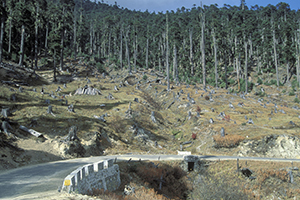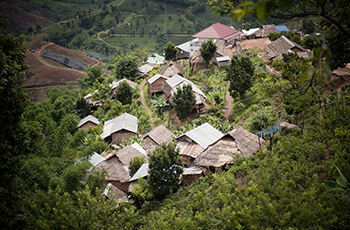Research Brief
Maximizing the Effectiveness of Foreign Aid in the Forestry Sector
- Forest degradation remains a leading environmental problem, given the scale of forest loss and the crucial role of forests to both climate change mitigation and adaptation.
- Initiatives from the climate change policy arena, especially REDD+, are opening new ways for a broader mainstreaming of forest management.
- While REDD+ is a new kind of policy, such initiatives need to draw lessons and best practices from decades of donor investment into developing tropical forests.
The global degradation of forests
Forests serve a range of key functions in an ecosystem, including many related to climate change, conservation of biodiversity, provision of water resources, and soil protection. Moreover, different estimates put the number of people who directly depend on forests for their livelihoods at between half a billion and 1.6 billion people.
Nevertheless, the forestry sector continues to be under intense pressure. Between 2000 and 2010, approximately 13 million hectares of forests were converted annually to other uses or were lost through natural causes. Moreover, many remaining forests are subject to relatively weak governance and mismanagement.
The general lack of global progress on improving tropical resource management is linked to widespread agricultural expansion, global demands for tropical hardwoods, a general lack of monitoring and enforcement, and environmental stresses that amplify natural hazards.
Lessons from past forest conservation and management
Forest conservation and management require long-term, stable funding. While the scale of foreign aid directed towards forests has increased dramatically in recent years, historical financing for sustainable forest management and forest conservation efforts have been inadequate.
 Win-win solutions are commonly proposed in the forestry sector. For example, some solutions accommodate forest conservation, while at the same time allow for the harvesting of resources. However, win-win solutions are often unrealistic. In forest management there are trade-offs between carbon sequestration on the one hand and, on the other, biodiversity conservation, climate change mitigation and adaptation targets, as well as other conservation and development goals.
Win-win solutions are commonly proposed in the forestry sector. For example, some solutions accommodate forest conservation, while at the same time allow for the harvesting of resources. However, win-win solutions are often unrealistic. In forest management there are trade-offs between carbon sequestration on the one hand and, on the other, biodiversity conservation, climate change mitigation and adaptation targets, as well as other conservation and development goals.
There is also growing recognition that while interventions at a specific site can have positive outcomes, broader-scale management is also necessary to maximize conservation and maintain diverse ecosystem functions. In the specific context of climate change mitigation, for example, larger-scale management potentially reduces ‘carbon leakage’ in which interventions to reduce deforestation at one site simply displace pressures and increase emissions elsewhere.
Prior experiences also highlight the importance of regular monitoring and rule enforcement, especially given the fact that natural resources management is susceptible to corruption.
Sustainable forest management (SFM), initially established at during the 1992 United Nations Conference on Environment and Development (UNCED) in Rio de Janeiro, and further defined by the UN in 2008, is one of the most promising frameworks through which to balance often competing objectives within the forestry sector. SFM implies some degree of sustainable resource extraction in a way that also maintains other ecosystem functions. It is characterized by elements such as biological diversity, forest health and vitality, productive and protective functions of forest resources, and a strong legal framework. The results of SFM initiatives depend heavily on a strong governance context.
Making financing conditional
Today, Reducing Emissions from Deforestation and Forest Degradation (REDD+) is at the forefront of climate change mitigation policy. REDD+ aims to reduce carbon emissions in the forestry sector and enhance carbon stocks (e.g., through reforestation). Generally, REDD+ policies—which are highly synergistic with SFM policies—propose to channel funds from industrialized nations to developing tropical nations in order to support forest conservation interventions whereby REDD+ funds offset the loss incurred by landowners choosing conservation over other more profitable activities.
 REDD+ policies leverage incentives through conditional payments to promote voluntary conservation. Such schemes can potentially overcome some of the limitations of other conservation policy instruments, such as protected areas, because they offer alternative livelihoods for local communities, are more flexible, and allow for better targeting of higher-value areas.
REDD+ policies leverage incentives through conditional payments to promote voluntary conservation. Such schemes can potentially overcome some of the limitations of other conservation policy instruments, such as protected areas, because they offer alternative livelihoods for local communities, are more flexible, and allow for better targeting of higher-value areas.
Lessons for donors
There is growing consensus that public financing is needed to operationalize REDD+. Yet, despite considerable donor pledges, long-term, large-scale voluntary public finance cannot yet be assured. As such, the current architecture of REDD+ financing poses risks to its financial sustainability.
In many tropical developing countries, forest governance reform related to law enforcement, land tenure clarity, benefit-sharing mechanisms or transparency and accountability of forest monitoring systems are required to improve sustainable forest management and maximize foreign aid. Donors should engage with the forestry sector through national, sub-national, and local institutions. Donors may also promote collaboration among the diverse stakeholders with interests in the forestry sector including landowners, civil society, and local service users.
An added challenge is that REDD+ interventions may increase centralized management of forest resources, at the cost of local management rights. This may seriously affect indigenous people’s rights over their traditional lands and resources. As such, ensuring that REDD+ reforms address issues such as local land tenure, resource access, autonomy or participation and benefit distribution is essential.
- There is potential for transformational changes as a result of the new REDD+ policies, but its long-term financial sustainability remains uncertain.
- Financing for the forestry sector cannot be addressed independently of governance considerations and without proper acknowledgement of a range of trade-offs associated with REDD+.
- International donors have a role in forest sustainability via engagement with participating countries, foreign aid and conditionality. This includes addressing many of the underlying governance issues and policy trade-offs associated with REDD+.
Trade-offs between carbon sequestration and biodiversity conservation, economic and human development, and climate change adaptation need to be candidly addressed as a condition for REDD+ implementation. This will help avoid undesirable outcomes, maximize donor resources, and ensure the permanence of conservation actions.
Finally, resources and donor support for the forestry sector must address the distribution of financial benefits, as to date it is not clear how REDD+ funds will be shared within recipient countries.
 Join the network
Join the network